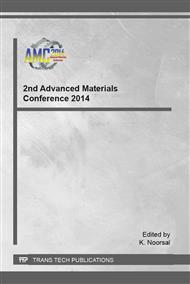[1]
Y. Zhang, J. Binner, Enhanced casting rate dynamic heating during slip casting, European Ceramic Society. 22 (2002) 135-142.
DOI: 10.1016/s0955-2219(01)00243-6
Google Scholar
[2]
T. Banno, Y. Hotta, S. Sano, A. Tsuzuki, KiichiOda, Cake growth control in slip casting, European Ceramic Society. 21 (2001) 879-882.
DOI: 10.1016/s0955-2219(00)00290-9
Google Scholar
[3]
N.H. Saad, A.R.M. Sahab, T.W. Dung, R. Ramli, Z.A. Wahid, Development Of ferrule Mould for ceramic injection molding process, The 6th International Conference on Electronics Materials and Packaging, EMAP (2004).
Google Scholar
[4]
S. Scaffoner, G. Christos, Aneziris, Pressure slip casting of coarse grain oxide ceramics, Ceramic International. 38 (2012) 417-422.
DOI: 10.1016/j.ceramint.2011.06.064
Google Scholar
[5]
I.A.H. Al-Dawery, J.G.P. Binner, G. Tari, P.R. Jackson, W.R. Murphy, M. Kearns, Rotary moulding of ceramic hollow wares, European Ceramic Society. 29 (2009) 887-891.
DOI: 10.1016/j.jeurceramsoc.2008.07.021
Google Scholar
[6]
R. Mehta, Hollow Ceramic Components Produced by Rotary Moulding Cuts Costs, Material World Magazine, London, (2007).
Google Scholar
[7]
R.J. Crawford, S. Gibson, Rotational Molding: The Basics for Designers, Rotoworld, March-April (2006).
Google Scholar
[8]
N.H. Saad, A.R.M. Sahab, M.H. Ibrahim, N. Rasid, The enhancement of CAD/CAM technology in ceramic industry, Third International Conference on Advanced Manufacturing Technology, (2004).
Google Scholar
[9]
R. Janssen, S. Scheppokat, N. Claussen, Tailor-made ceramic-based components – Advantages by reactive processing and advanced shaping techniques, European Ceramic Society. 28 (2008) 1369-1379.
DOI: 10.1016/j.jeurceramsoc.2007.12.022
Google Scholar
[10]
K.M. Linqvist, E. Calstrom, Indirect solid freeform fabrication by binder assisted slip casting, European Ceramic Society. 25 (2005) 3539-3545.
DOI: 10.1016/j.jeurceramsoc.2004.10.013
Google Scholar
[11]
A. Tsetsekou, C. Agrafiotis, A. Milias, Optimization of the rheological properties of alumina slurries for ceramic processing applications Part 1: Slip-casting, European Ceramic Society. 21 (2001) 363-373.
DOI: 10.1016/s0955-2219(00)00185-0
Google Scholar
[12]
G. Tari, J.F. Ferreira, Influence of solid loading on drying-shrinkage behavior of slip cast bodies, European Ceramic Society. 18 (1998) 487-493.
DOI: 10.1016/s0955-2219(97)00161-1
Google Scholar
[13]
J.G.P. Binner, I. Santacruz, Rheoligical characterization of electrosterically dispersed alumina suspension during in situ coagulation, American Ceramics Society. 89 (2006) 863-868.
DOI: 10.1111/j.1551-2916.2005.00834.x
Google Scholar
[14]
J.G.P. Binner, A.M. McDermott, Y. Yin, R.M. Sambrook, B. Vaidhyanathan, In situ coagulation moulding: a new route for high quality, net-shape ceramics, Ceramics International. 32 (2006) 29-35.
DOI: 10.1016/j.ceramint.2004.12.006
Google Scholar


